Are there water snakes in Utah? No. Strictly speaking, there are no water snakes in Utah. True water snakes are contained in the genus Nerodia. Snakes in this genus are commonly called water snakes because they are often found in or near water sources such as rivers, lakes, and swamps. There are currently 11 recognized species in the genus Nerodia, and Utah is not home to any of them. However, if you are communing with nature near lakes or rivers in Utah, you might spot a snake here and there. Though Utah isn’t home to any true water snakes, it is nonetheless home to 31 snake species, many of which may be found in or near bodies of water. Keep reading to learn about the snakes you’re most likely to encounter in the waters of Utah.
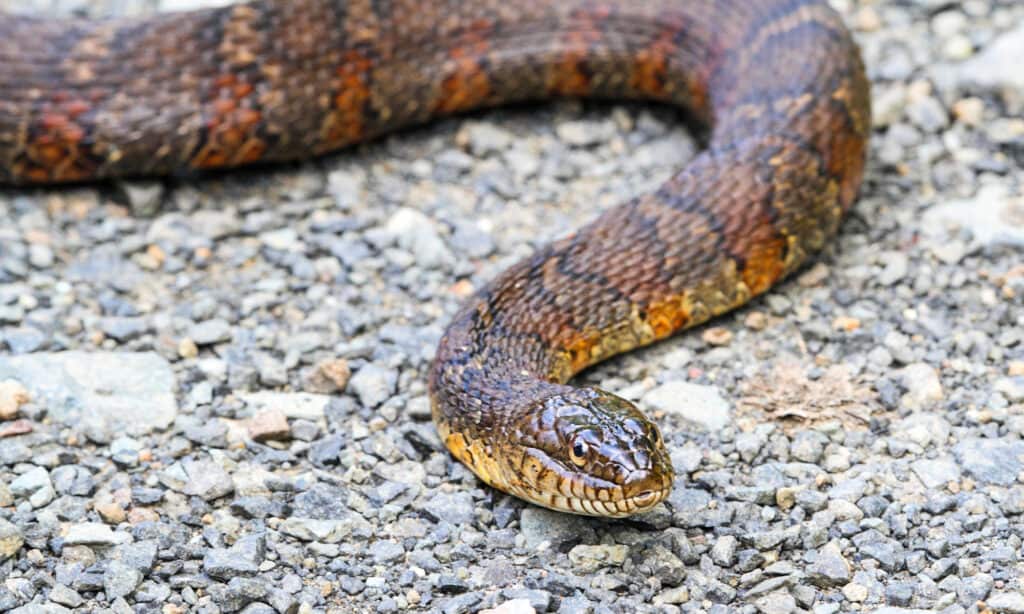
True water snakes are contained in the genus
Nerodia.Pictured: Northern Water Snake (
Nerodia sipedon)
©Steve Byland/Shutterstock.com
Thamnophis
The genus Thamnophis is a group of colubrid snakes commonly known as garter snakes. Garter snakes are found throughout North America, from the subarctic regions of Canada to Central America, and they are known for their colorful and distinctive patterns. Garter snakes live in a variety of habitats ,but are never far from a body of water. Utah is home to the three species of snakes contained in the genus Thamnophis.
Blackneck Garter Snake
Thamnophis crops, the blackneck garter snake, is a species of nonvenomous colubrid snake native to North America. It is found primarily in the Southwestern United States and Northern Mexico. The blackneck garter snake is named for the dark band that extends across its neck and onto the sides of its head. It is a relatively small snake, with adults typically measuring between 11-23 inches (30-60 cm) in length. These snakes are typically found in riparian habitats. They live near streams, and wetlands, where they feed on a variety of prey species including fish, amphibians, and invertebrates. Blackneck garter snakes are nonvenomous and are generally considered harmless to humans.
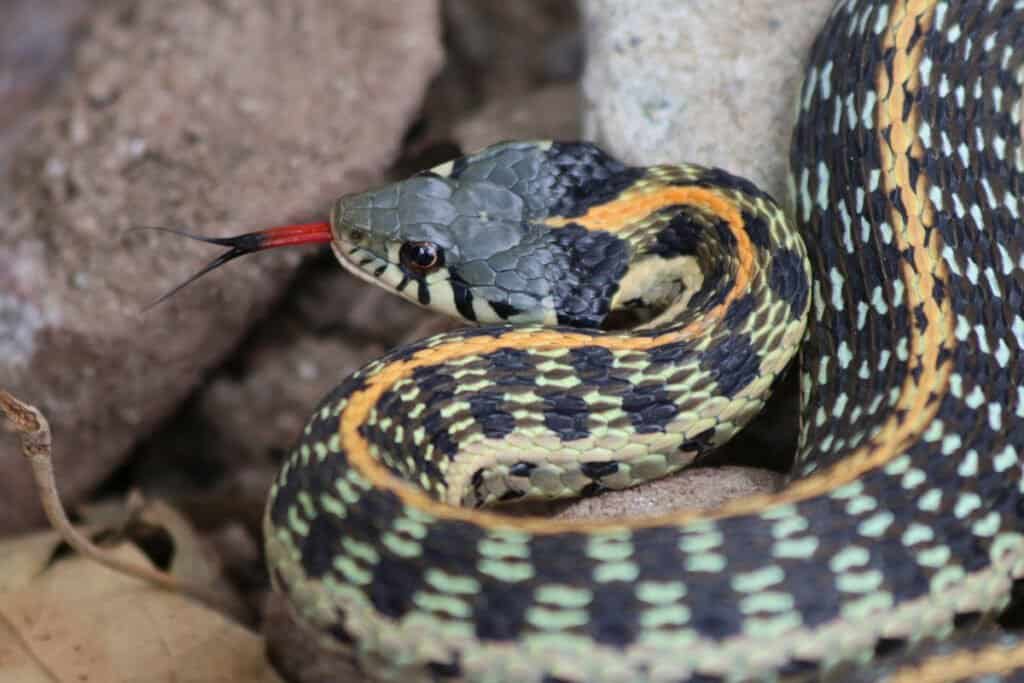
Blackneck garter snakes are nonvenomous and are generally considered to be harmless to humans.
©Creeping Things/Shutterstock.com
Valley Garter Snake
The valley garter snake (Thamnophis sirtalis fitchi) is a subspecies of the common garter snake. The valley garter snake is found in the Central and Western United States, including the Great Plains, Rocky Mountains, and Pacific Northwest. This subspecies is known for its distinctive coloration, which consists of three longitudinal stripes running the length of the body. The middle stripe is typically yellow or green in color, while the two lateral stripes are black, punctuated with orange or red.
The valley garter snake has a relatively long, slender body. Adults typically grow to be around 17-27 inches (45-70 cm) long. Valley garter snakes are primarily found near riverbanks, marshes, and wetlands,. They feed on a variety of prey items including fish, amphibians, and invertebrates. Like most other garter snakes, valley garter snakes are nonvenomous and harmless to humans
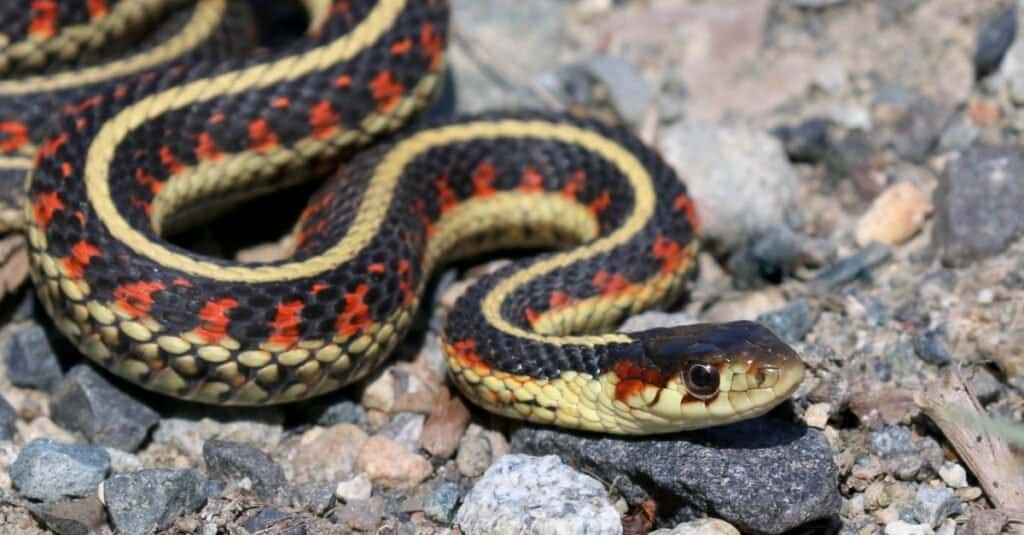
Valley garter snakes have larger eyes and smallish heads.
©iStock.com/randimal
Western Terrestrial Garter Snake
The Western terrestrial garter snake (Thamnophis elegans) is a relatively small snake. Adults will typically grow to be 11-23 inches (30-60 cm) long. It has a distinctive color pattern, with three longitudinal stripes running the length of its body. The lines can be green, yellow, or white.
This snake is primarily a terrestrial species, but it is also known to be a good climber and swimmer. It is commonly found in grasslands, meadows, forests, and wetlands. It feeds on a variety of prey, including insects, small amphibians, and earthworms. There are several recognized subspecies of Thamnophis elegans, each with its own distinct range and coloration. The Western terrestrial garter snake is mildly venomous. These snakes have venomous saliva that paralyzes small prey, however, they do not pose a threat to humans. There are several recognized subspecies of Thamnophis elegans, each with its own distinct range and coloration.

The Western terrestrial garter snake is mildly venomous. These snakes have venomous saliva that paralyzes small prey, however, they do not pose a threat to humans.
©Hunter Kauffman/Shutterstock.com
Southwestern Blackhead Snake
The Southwestern blackhead snake,(Tantilla hobartsmithi) also called Smith’s blackhead snake or Smith’s black-headed snake is a small, nonvenomous snake that is native to the Southwestern United States and Northern Mexico. These snakes prefer habitats such as stream and river bottoms
The Southwestern blackhead Snake can grow up to 12 inches (30 cm) long but typically range between 6-9 inches (15-22 cm) in length. They have slender bodies and black heads, with a brown or grayish-brown coloration on their body. Like many other species of Tantilla, they primarily feed on small invertebrates such as centipedes, spiders, and earthworms. Their preference for stream and river bottoms may be due to the abundance of their preferred prey in these areas, as well as the availability of moist soil, which is important to their survival.

The Southwestern blackhead snake can grow up to 12 inches (30 cm) long but typically range between 6-9 inches (15-22 cm) in length.
©Erin Donalson/Shutterstock.com
Great Basin Gopher Snake
The Great Basin gopher snake (Pituophis catenifer deserticola) is the largest snake species found in Utah. It is a subspecies of the gopher snake (Pituophis catenifer ). The Great Basin gopher snake is found in a variety of habitats, including desert, scrubland, and grassland. Great Basin gopher snakes can grow up to 6 feet (1.8 m) in length, although they are more typically 4-5 feet (1-1.5 m) long. They are relatively heavy-bodied snakes, with a pattern of dark blotches on a lighter background.
The coloration of the Great Basin gopher snake varies depending on the habitat in which it is found. They range from tan, yellow, gray or brown. Their belly is typically a lighter color than their back, with arrow-shaped heads. As their name suggests, gopher snakes feed primarily on small mammals. Thir diet consists of rodents such as gophers, ground squirrels, rabbits, and other small mammals. They also eat lizards, birds, and their eggs.
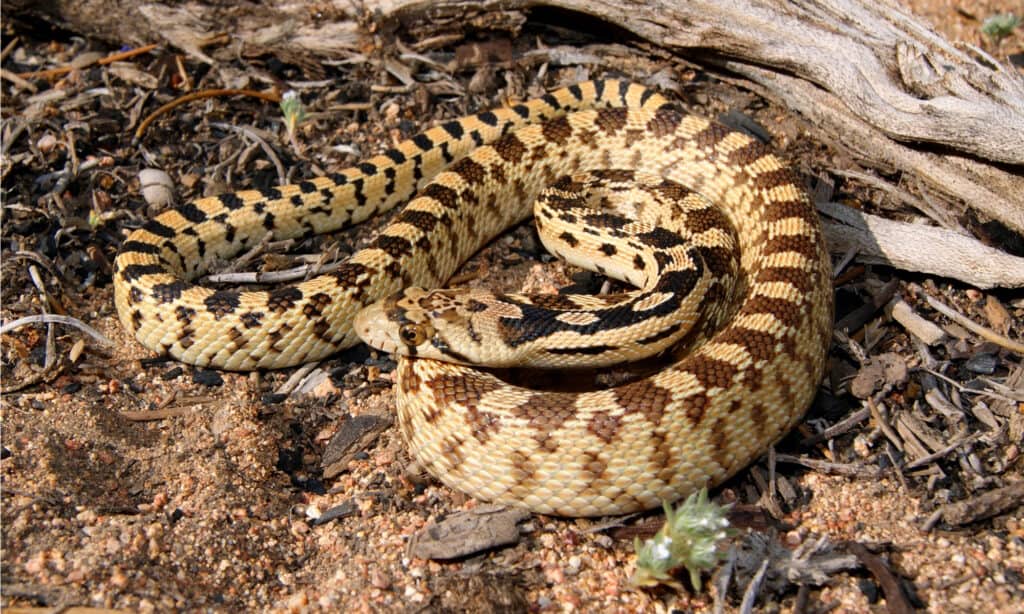
Great Basin Gopher Snake (
Pituophis catenifer deserticola) is the largest snake species found in Utah.
©Matt Jeppson/Shutterstock.com
Striped Whipsnake
The striped whipsnake (Masticophis taeniatus), is a species of nonvenomous colubrid snake found in the Southwestern United States and Northern Mexico.
As their name suggests, striped whipsnakes are slender and have a long, whip-like tail that they use to help them move quickly through their habitat. They can grow up to 6 feet (1.8 m) long but are typically 3-5 feet (0.5-1.5 m) long. They have a distinctive striped pattern on their body, with a dark brown or black coloration on their head and tail and lighter stripes on their body.
Striped whipsnakes are primarily diurnal, meaning that they are active during the day. They feed on a variety of small prey, including lizards, birds, rodents, and other snakes. They are fast and agile hunters, using their speed and agility to catch their prey.
Striped whipsnakes are also known for their defensive behavior. When threatened, they will coil their body and vibrate their tail, making a sound that is similar to that of a rattlesnake. This behavior is meant to intimidate potential predators and discourage them from attacking. Striped whipsnakes are found in a variety of habitats, including deserts, grasslands, scrublands, and around the edges of rivers and ponds.

When threatened, striped whipsnakes will coil their body and vibrate their tail, making a sound that is similar to that of a rattlesnake.
©Steve Schlaeger/Shutterstock.com
Great Plains Rat Snake
The Great Plains rat snake (Pantherophis emoryi) is a nonvenomous colubrid snake that is found throughout much of the central and western United States. It is a subspecies of Emory’s rat snake, which is found in other regions of North America. The Great Plains rat snake is a relatively large snake, with adults measuring 3-5 feet (0.5-1.5 m) in length, although some individuals may reach up to 6 feet (1.8 m) long. Their bodies are patterned with brown or grayish-brown blotches on a lighter background, which may be yellow, tan, or gray. Their bellies are typically a lighter color than their back.
As their name suggests, Great Plains rat snakes primarily feed on small rodents, such as rats and mice, although they may also eat other small animals such as birds and lizards. They are constrictors, which means that they kill their prey by squeezing it until it suffocates. Like the striped whipsnake, when Great plains rat snakes feel threatened, they will coil their body and hiss loudly, while vibrating their tail. This behavior is meant to intimidate potential predators and discourage them from attacking. Great Plains rat snakes are found in a variety of habitats, including grasslands, scrublands, and woodlands. The can also be found near rivers and streams.
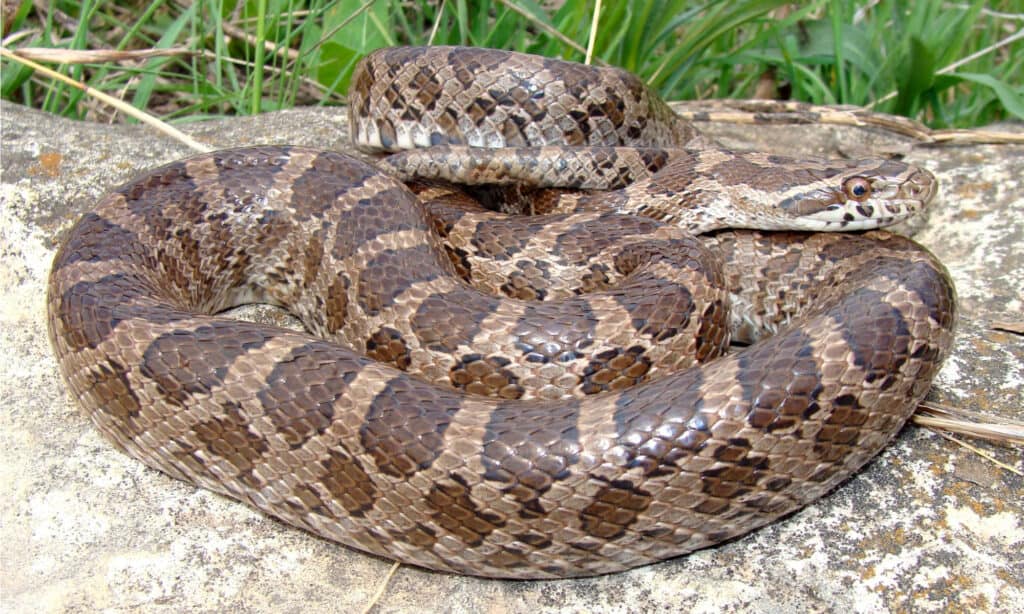
Great Plains Rat Snake coils up and shakes its tail in an effort to scare away threats.
©Matt Jeppson/Shutterstock.com
The photo featured at the top of this post is © Alyssa Metro/Shutterstock.com
Thank you for reading! Have some feedback for us? Contact the AZ Animals editorial team.






